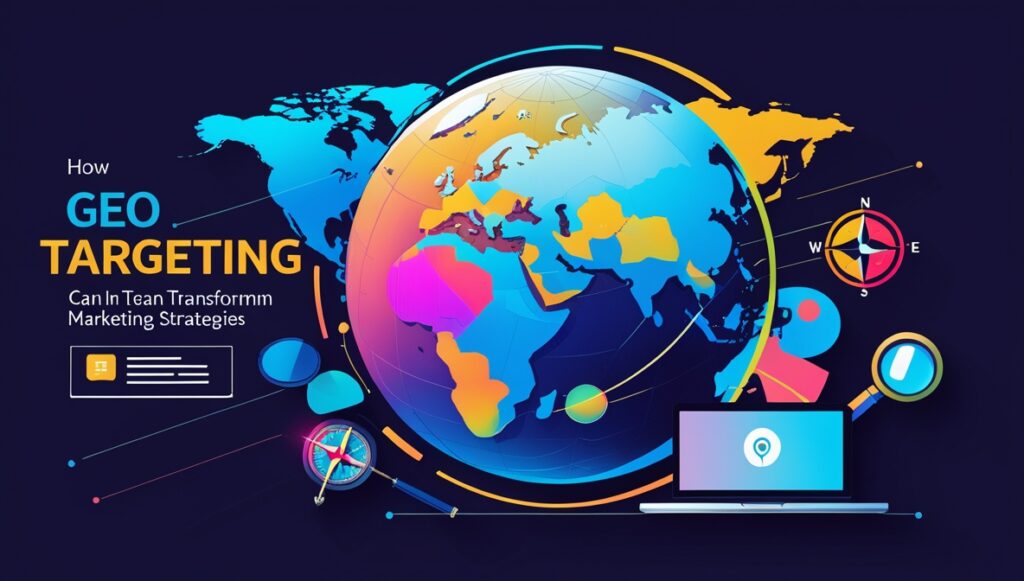Geo-targeting is a highly effective yet often underutilized strategy in digital marketing. By leveraging location-specific data, businesses can deliver personalized messages and tailored campaigns that resonate with users based on their geographic location. This approach enables brands to connect more deeply with their target audiences, improve engagement rates, and ultimately enhance overall return on investment (ROI).
Many companies partner with a geo marketing agency to harness the full potential of geo targeting, benefiting from expert knowledge and specialized technology. By incorporating geo targeting into your marketing strategy, you can deliver highly relevant content, promotions, and advertisements to audiences where they are, dramatically improving engagement, conversion rates, and overall campaign success.
This article explores how geo targeting can transform your marketing approach, highlights the various techniques and technologies involved, and provides actionable insights for integrating geo targeting into your marketing toolkit.
GEO Targeting: The Basics
Geo targeting, sometimes referred to as location-based marketing, involves identifying the geographic location of a prospective customer and tailoring marketing efforts to that specific location. This can include targeting users by country, region, city, postal code, or even a very precise radius around a physical store or event.
The rise of mobile devices equipped with GPS technology, the expansion of IP address mapping, and advanced data analytics tools have made geo targeting more accessible and effective than ever before. Businesses can now deliver personalized offers, relevant ads, and localized content to consumers in real-time based on their location data.
Types of Geo Targeting
- IP-Based Targeting: Uses the IP address of the user to approximate their location, often down to the city or region level.
- GPS-Based Targeting: Leverages the GPS data from smartphones or mobile devices to pinpoint exact locations, enabling hyper-local marketing.
- Wi-Fi and Beacon Technology: Utilizes Wi-Fi networks or Bluetooth beacons to engage users within a specific physical location, such as a retail store.
- Device Location Settings: Depends on device settings where users share location information voluntarily, allowing for personalized push notifications or app experiences.
Why Geo Targeting Matters in Modern Marketing
The modern consumer expects highly relevant and timely interactions with brands. Generic, one-size-fits-all marketing messages fail to capture attention or drive meaningful engagement. Geo targeting meets these expectations by offering several key benefits:
1. Enhanced Personalization
Personalization is the cornerstone of effective marketing. Geo targeting adds a critical dimension by enabling marketers to customize messaging based on where a consumer is located. For example, a coffee shop chain can send a discount coupon to potential customers within a few miles of their store, while a global apparel brand can promote region-specific styles based on local trends and weather conditions.
2. Improved Customer Engagement
Location-based marketing increases the chances that consumers will engage with a campaign because the content feels relevant and timely. Customers appreciate offers or information that align with their immediate context—such as a lunch special near their office or alerts about events happening in their neighborhood.
3. Higher Conversion Rates
By targeting users at the right place and time, geo targeting increases the likelihood of conversions. According to studies, consumers are significantly more likely to act on location-specific offers, whether that means visiting a store, redeeming a coupon, or making an online purchase.
4. Cost Efficiency and Better ROI
Geo targeting helps eliminate wasted ad spend by focusing marketing dollars only on audiences that matter most geographically. This precision reduces scattergun advertising, optimizes budget allocation, and ultimately improves campaign ROI.
5. Competitive Advantage
Businesses that leverage geo targeting gain a competitive edge by delivering more relevant experiences than their competitors. Localized marketing fosters stronger brand loyalty and drives repeat business.
Practical Applications of Geo Targeting in Marketing
Geo targeting’s versatility allows it to enhance marketing strategies across various industries and channels. Here are some real-world applications that illustrate its transformative potential:
Retail and E-Commerce
For retail businesses, geo targeting enables hyper-local advertising that drives foot traffic to brick-and-mortar stores. For example, a retailer can use beacon technology to send personalized promotions to customers as they enter a shopping mall or specific store section.
E-commerce businesses can benefit by offering location-specific shipping information, pricing, or promotions. For instance, displaying regional sales tax, currency, or delivery estimates helps reduce friction during the purchase process.
Hospitality and Travel
Travel companies and hotels utilize geo targeting to promote nearby attractions, offer last-minute deals to travelers in specific cities, or send welcome messages when guests arrive at a destination. Airlines can tailor advertisements based on frequent flyer locations or destinations popular within a given region.
Food and Beverage
Restaurants and cafes capitalize on geo targeting by offering timely lunch specials or happy hour discounts to potential customers nearby. Food delivery services use geo targeting to optimize delivery zones, recommend local favorites, and personalize offers.
Events and Entertainment
Event organizers use geo targeting to market concerts, festivals, and sporting events to residents and visitors within a targeted radius. Geo-targeted push notifications or social media ads can build excitement and increase ticket sales.
Real Estate
Real estate agents deploy geo targeting to showcase listings to buyers actively searching within specific neighborhoods or zip codes. Virtual tours and open house notifications can be tailored to prospective buyers’ locations, streamlining the customer journey.
Geo Targeting Across Marketing Channels
To maximize the impact of geo targeting, marketers can integrate it into various digital and offline channels:
1. Social Media Advertising
Platforms like Facebook, Instagram, Twitter, and LinkedIn offer robust geo targeting options. Marketers can create hyper-targeted campaigns based on location parameters, including cities, postal codes, or even user check-ins. This enables brands to engage local communities or specific regions with tailored content and offers.
2. Search Engine Marketing (SEM)
Google Ads and Bing Ads allow advertisers to target users based on location. This is especially valuable for businesses with physical storefronts or services limited to certain regions. By focusing search ads on geo-specific keywords and locations, marketers improve ad relevance and quality scores.
3. Email Marketing
Email marketing platforms increasingly support geo-targeted segmentation. Businesses can send region-specific newsletters, promotions, or event invitations. Including location-specific details, such as store hours or local events, enhances relevance and boosts open rates.
4. Mobile and In-App Advertising
Mobile apps offer unparalleled geo targeting capabilities through GPS and device location services. Businesses can deliver push notifications, in-app messages, or location-triggered alerts to users in close proximity, driving real-time engagement.
5. Display and Programmatic Advertising
Display networks enable geo-targeting to show ads only to users in selected locations. Programmatic advertising platforms allow marketers to set geographic filters, optimizing ad delivery and increasing the likelihood of conversions.
How to Implement Geo Targeting Effectively
Geo targeting can unlock significant value, but success requires careful planning and execution. Consider the following best practices:
1. Define Clear Objectives
Start with a clear understanding of what you want to achieve through geo targeting. Whether it’s driving local foot traffic, boosting online sales in specific regions, or promoting event attendance, your objectives will shape your targeting strategy.
2. Segment Your Audience by Location
Segment your audience into geographic groups that make sense for your business goals. These segments could be as broad as countries or as granular as neighborhoods, depending on your product or service.
3. Create Relevant, Location-Specific Content
Tailor your messaging to reflect the preferences, culture, and conditions of each targeted location. Highlight local landmarks, weather, events, or other factors that resonate with the audience.
4. Use the Right Technology Stack
Choose platforms and tools that offer robust geo targeting capabilities aligned with your marketing channels. From social media ad managers to programmatic platforms and CRM systems, technology will enable precise targeting and measurement.
5. Monitor and Optimize Campaigns
Track campaign performance by location to identify what works best. Use analytics to refine your geo targeting strategy, adjust budget allocations, and improve messaging for underperforming regions.
6. Respect Privacy and Compliance
Ensure your geo targeting practices comply with data privacy regulations such as GDPR, CCPA, or others relevant to your region. Be transparent with users about data collection and usage, and provide opt-out options where necessary.
Overcoming Common Challenges in Geo Targeting
Despite its advantages, geo targeting presents several challenges that marketers must navigate:
Data Accuracy and Reliability
Location data can vary in accuracy depending on the source. GPS data is highly precise, but IP-based location can be less reliable. Marketers should verify the quality of location data and use multiple signals when possible to improve accuracy.
Privacy Concerns
Consumers are increasingly aware of privacy issues and may hesitate to share location data. Marketers must prioritize transparency, obtain user consent, and safeguard personal information.
Over-Targeting Risks
Overusing geo targeting or delivering repetitive location-specific ads may lead to ad fatigue or customer annoyance. Striking the right balance is key to maintaining engagement without overwhelming your audience.
The Future of Geo Targeting in Marketing
Geo targeting is evolving rapidly with advances in artificial intelligence (AI), machine learning, and augmented reality (AR). Predictive analytics can anticipate consumer behavior based on location patterns, enabling even more precise and timely marketing interventions.
AR-powered experiences integrated with geo targeting promise immersive and interactive marketing campaigns, such as virtual tours or location-based games that engage consumers on a deeper level.
As 5G networks expand, delivering faster and more reliable connectivity, geo targeting will become even more dynamic, allowing marketers to reach users instantly and in real-time with personalized content.
Conclusion
Local business growth through geo marketing services is one of the key benefits of geo targeting. Geo targeting stands as a transformative tool in the modern marketer’s arsenal. By harnessing the power of location data, businesses can move beyond generic marketing to deliver highly personalized, relevant, and timely messages that resonate deeply with consumers. From enhancing customer engagement to improving conversion rates and maximizing ROI, geo targeting empowers marketers to connect with their audience in meaningful ways wherever they are.
To truly capitalize on geo targeting, marketers must approach it strategically, invest in the right technology, respect privacy, and continuously optimize campaigns based on data insights. When implemented thoughtfully, geo targeting doesn’t just improve marketing outcomes; it redefines how brands engage with their customers in an increasingly connected world.
Are you ready to transform your marketing strategy through geo targeting? Embrace this powerful technique today and watch your brand’s relevance and impact soar.



